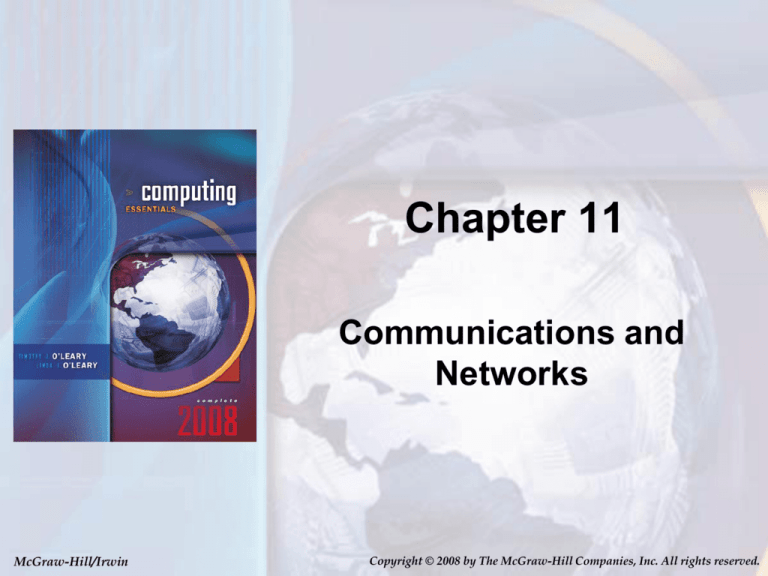
Chapter 11
Communications and
Networks
McGraw-Hill/Irwin
Copyright © 2008 by The McGraw-Hill Companies, Inc. All rights reserved.
Competencies (Page 1 of 2)
• Discuss connectivity, the wireless revolution, and
communication systems
• Describe physical and wireless communications
channels
• Discuss connection devices, including modems, T1,
DSL, cable modem, satellite, and cellular
connections
• Describe data transmission factors, including
bandwidths and protocols
9-2
Page 246
Competencies (Page 2 of 2)
• Discuss networks and key network
terminologies.
• Describe different types of networks,
including local area, metropolitan area,
and wide area networks.
• Describe network architectures,
including configurations and strategies.
• Describe organizational uses of Internet
technologies, including intranets,
extranets, and firewalls.
9-3
Page 246
Introduction
Cell phones and other wireless
technologies are allowing us to stay
connected in today’s world like never
before. Increased connectivity
potentially means increased
productivity especially in the business
world. You will learn more about the
concept of connectivity and the impact
of the wireless revolution in this
chapter.
9-4
Page 247
Communications
The process of sharing data, programs, and
information between two or more computers
9-5
Page 248
Communications Today
• Numerous applications depend on
communication systems—E-mail, Instant
messaging (IM), Internet telephone, and
Electronic commerce
• Connectivity uses computer networks to link
people and resources
• Going wireless has been the most dramatic
change
9-6
Page 248
Communication Systems
• Four basic elements
–
–
–
–
Sending and receiving devices
Communication channel
Connection devices
Data transmission specifications
9-7
Page 249
Communication Channels
• Channels carry data from one computer
to another
• Two categories of communication
channels
– Physical connection
– Wireless connection
9-8
Page 250
Physical Connections
• Telephone lines
(Twisted pair cables)
• Coaxial cable
• Fiber-optic cable
Return
Page 250
9-9
Wireless Connections
• Infrared
• Broadcast radio
– Wi-FI (wireless
fidelity) 802.11
Microwave dish
• Microwave
– Stations
– Bluetooth
• Satellite
– GPS
Satellite
GPS
Page 252
9-10
Communication Channels
Summary
9-11
Page 253
Connection Device Signals
• Types of signals
– Analog
– Digital
9-12
Page 253
Connection Device Types and
Transfer Speeds
• Types of modems
– External
– Internal
– PC Card
– Wireless
Transfer Speeds
9-13
Page 253
Connection Service
• Dial-Up services
• Leased lines – T1, T2, T3 and T4
• Digital subscriber line (DSL)
– Uses existing phone lines
– One type widely used is ADSL
• Cable modems
– Uses existing TV cable
– Provides speeds as fast as DSL at a lower cost
• Satellite/air connection services
– Seven times faster than dial-up
– Slower than DSL & cable modem
• Cellular Services
– Alternative for mobile devices and laptops
– Current service areas limited
9-14
Page 254
Typical User Connection Costs &
Speeds
9-15
Page 255
Bandwidth
• Measurement of the capacity of the
channel
• Categories
– Voiceband also known as low bandwidth
– Medium band
– Broadband
• Used for high capacity transmission
• Used by DSL, cable, and satellite
9-16
Page 255
Protocols
• Set of communication rules
• Standard for Internet: TCP/IP
(Transmission control protocol/Internet
protocol)
– Identification
– Reformatting
9-17
Page 256
Networks
• A computer network is a
communication system
• Connects two or more computers
• Allows information exchange
9-18
Page 257
Computer Networks
Computer Networks Connect Computers
Common network terms
• Node
• Client
• Server
• Hub
• Network interface cards (NIC)
• Network operating system
(NOS)
• Distributed processing
• Host computer
• Network administrator
9-19
Page 257
Network Types
• Local area networks
• Home networks
– WLAN
• Metropolitan
networks
• Wide area networks
area
LAN
9-20
Page 259
Network Architecture
• Architecture describes how a network
is arranged
• Arrangement is called topology
• Types of network topology
– Star
– Bus
– Ring
– Hierarchical
9-21
Page 261
Star Network
• Smaller computers
linked to a central
unit
• Central unit is called
the network hub
• Control is
maintained by
polling
Return
Page 251
9-22
Bus Network
• Each device handles its own communication
control
• There is no host computer
• Has a common connecting cable called a
backbone
Return
9-23
Page 264
Ring Network
• Each device is
connected to two
other devices
• No central file
server or computer
• Useful in a
decentralized
environment
Return
Page 264
9-24
Hierarchical Network
• Several computers
linked to a central
host
• Computers are
hosts to other
computers
• Useful in centralized
organizations
9-25
Page 264
Principal Network Configurations
9-26
Page 265
Strategies
• Strategy is a way of
coordinating the
sharing of
information and
resources
• Common network
strategies
– Terminal
– Client/server
– Peer-to-peer
9-27
Page 255
Organizational Internets
• Intranets
– Private network within an
organization
– Provides information to
employees
• Extranets
– Private network that connects
organizations
– Used to allow suppliers and
others access
• Firewalls
– Security system
– Protects against external threats
Page 268
9-28
Careers In IT
• Network Administrator
– Manage a company’s
LAN and WAN networks
– Maintain hardware and
software
– Diagnose and repair
problems
– Candidates usually have
a bachelor’s degree in
computer science and
practical experience
– Annual salary is typically
between $43,000 and
$68,000
9-29
Page 270
A Look to the Future
Cars that Monitor and Respond
• Pod car (Personalization on Demand)
• Predicts and responds
• Designed to learn and adapt to an
individual's driving needs and habits
9-30
Page 271
Discussion Questions (1 of 2)
• Define and discuss connectivity, the
wireless revolution, and
communications.
• Identify and describe the various
physical and wireless communication
channels.
• Identify the standard Internet protocol
and discuss its essential features.
9-31
Page 278
Discussion Questions (2 of 2)
• Define and discuss the four principal
network topologies.
• Define and discuss the three most
common network strategies.
9-32
Page 278











